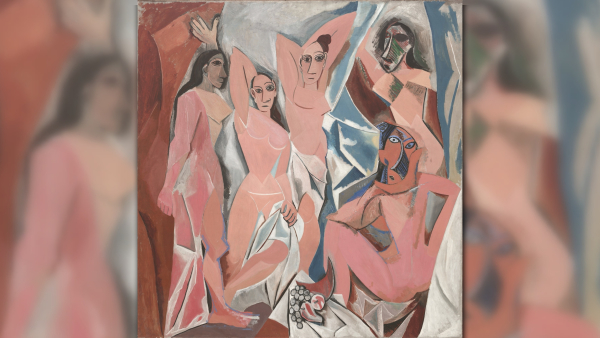Cubism is an artistic movement that emerged in France at the beginning of the 20th century. Cubist works sought to represent elements of nature through geometric shapes, mainly the cubic ones.
Thus, the Cubist style was opposed to the realism of the images that were portrayed during the Renaissance, for example. The principles that define Cubist art are present both in the visual arts and in literature.
To better understand the essence of this movement, check out some of its main features in art:
Valorization of geometric and fragmented shapes

girl with mandolin (1910), Pablo Picasso
As the movement's name suggests, Cubism's main characteristic is the use of geometric shapes as a prominent component in the works.
The cubist artist seeks the simplification of the world in his paintings and, for that, he appropriates cubes, cones, cylinders and other geometric shapes with straight and simple lines.
This geometrized figurativism should not be confused with abstract art, because unlike abstract art, in Cubist works, forms have a certain level of identification.
In synthetic cubism, for example, figures are easily associated with objects or people, even though they are constructed from geometric shapes.
Use of "plastic rhymes"

La fenetre aux collines (1923), Juan Gris
The so-called "plastic rhyme" consists of a technique applied by some Cubist artists, where each geometric shape continued the other, creating a harmonious effect in the work.
This technique would have been created by the Spanish painter Juan Gris (1887 - 1927), one of the great disciples of Pablo Picasso, and precursor of the so-called synthetic cubism (name given to the second phase of the artistic movement).
Use of collage as an image reconstruction technique

The guitar (1913), Pablo Picasso
Unlike the proposal of Analytical Cubism, which sought to fragment real figures as much as possible, Synthetic Cubism sought to reconstruct the fragmented images, making them more recognizable.
For this, the collage technique began to be applied as one of the most common methods in the composition of these works. The artist introduced clippings from newspapers, magazines and pieces of other material (wood, glass, metal, etc) in painting, mixing textures and shapes to produce their work.
The collage's intention would be to transport the interaction between the viewer and the work beyond the visual field, also awakening tactile sensations in people.
Renunciation of perspective

Guernica (1937), Pablo Picasso
Predominantly during the first phase of Cubism (Analytical), the artists sought to present the different angles and perspectives of the work at the same time and under the same plan.
The three-dimensional object was fragmented, represented in geometric shapes and superimposed to create the illusion of three-dimensionality.
The construction of the images from the superimposed junction of these fragments conveys, for the artist, the sensation of "sculpting" the painting. From this comes the concept of sculptural painting, which also defines several works of the Cubist movement.
Predominance of monochromatic and opaque colors

Violin and Chandelier (1910), Georges Braque
Some of the main names in Analytical Cubism, such as Pablo Picasso, for example, characterized the his works by the use of dark and monochromatic colors, such as brown, gray, black, green, ocher and beige.
THE color palette was very limited, and in some works the difference was only between different shades of the same color.
It is noteworthy that the inspiration for the use of this restricted selection of colors is in African art, which influenced the works of Cézanne and Picasso (the main precursors of Cubism).
As the movement progresses, warmer and more vivid colors are used in Cubist works. The main responsible for this change was Juan Gris, the "creator" of Synthetic Cubism.
Work as a "mental exercise"

seated female nude (1910), Pablo Picasso
Cubism, especially the analytical one, is not limited to portraying the nature of the form it presents itself in reality, but rather an abstract conceptual idea of the objects that are inserted in it.
For this reason, Cubist works can be considered a "mental exercise" for the observer, who needs to interpret the image that presents itself fragmented and superimposed by different figures of the geometry.
Portrait of the Primitive

Les demoiselles d'Avignon (1907), Pablo Picasso
The forerunners of Cubism were strongly inspired by African art, mainly the idea of synthesis of elements and the monochromatic use of some restricted colors.
It is possible to see direct references to African masks and the concept of primitivism in various works by Paul Cézanne, during the so-called "pre-analytic cubism" or "Cezannean cubism".
Another work that shows the essence of this characteristic for the Cubist movement is Les Demoiselles d'Avignon, by Pablo Picasso. In the scene portrayed by the artist, there are women from a brothel in Barcelona, some of which appear wearing masks of African tribes.
Influenced by the Theory of Relativity
The Cubist movement emerged in the midst of a period of great scientific revolutions. At the beginning of the 20th century, for example, the world was in awe of Albert Einstein's Theory of Relativity (1879 - 1955).
The physicist defended the idea of existence of a fourth dimension, time-space, altering the traditional conception of a three-dimensional universe that had existed until then.
For cubist artists, especially Pablo Picasso, their works were not tied to the conventional notion of space and, therefore, he saw in Einstein's theories a great inspiration for the concept he applied in his works.
Learn more about Cubism.



